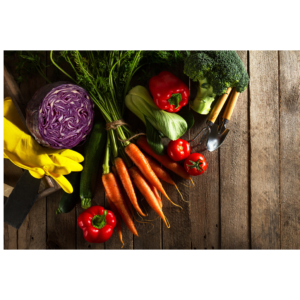The Essential Guide to Gardening: Start Your Garden from Scratch and Watch It Flourish
 Gardening is more than just a hobby; it’s a rewarding experience that connects you with nature, offers fresh, homegrown produce, and promotes physical and mental well-being. Growing your own fruits and vegetables allows you to enjoy pesticide-free, nutritious food while cultivating a peaceful and fulfilling environment right in your backyard.
Gardening is more than just a hobby; it’s a rewarding experience that connects you with nature, offers fresh, homegrown produce, and promotes physical and mental well-being. Growing your own fruits and vegetables allows you to enjoy pesticide-free, nutritious food while cultivating a peaceful and fulfilling environment right in your backyard.
Aside from the nutritional benefits, gardening has a therapeutic aspect. It helps reduce stress, promotes relaxation, and offers a sense of accomplishment as you nurture plants and witness their growth. Whether you’re a beginner or a seasoned gardener, this guide will equip you with everything you need to start and maintain a thriving garden. From choosing the right plants to creating the perfect layout, let’s dive into the essentials of gardening.
Getting Started
Before you begin, it’s important to assess your garden space. Key factors such as sunlight exposure, soil quality, and climate conditions will play a vital role in determining the types of plants you can grow successfully. A sunny spot with 6-8 hours of sunlight is ideal for most vegetables and flowering plants, but make sure to select varieties that suit your local climate.
Essential Gardening Tools
Investing in quality tools can make your gardening tasks more efficient and enjoyable. Here are some basic tools to start with:
- Gardening gloves
- Hand trowel
- Pruning shears
- Garden fork
- Watering can or hose
- Seed trays or pots
- Fertilizer and compost
- Mulch
- Drip irrigation system or rain barrels
- Tomato Seeds
- Pepper Seeds
- Cucumber Seeds
- Strawberry Seeds
These tools will help you prepare, plant, and care for your garden, ensuring that it thrives throughout the growing season.
Please Note: This post contains affiliate links, which means I may earn a commission if you make a purchase through these links. Your support helps keep this content free. Thank you for your understanding and support!
Designing Your Garden Layout
A well-planned garden layout is crucial for optimal plant growth and ease of maintenance. Begin by sketching out your garden area, keeping in mind the sunlight and space requirements of each plant. Consider incorporating pathways to make it easier to tend to plants, and perhaps even seating areas where you can relax and enjoy the fruits of your labor.
Choosing Plants
The plants you choose should match your climate, soil type, and sunlight exposure. It’s also important to consider factors like plant size, spacing, and growth habits. For example:
- Sun Requirements: Full sun, partial shade, or full shade
- Soil Type: Sandy, clay, or loamy soil
- Plant Size: Ensure that mature plants have enough space to grow
Selecting plants that are compatible with your environment will lead to a more successful and productive garden.
Starting Seeds Indoors
Starting seeds indoors allows you to extend your growing season and give your plants a head start, especially for vegetables that require a long growing period. Different plants have different schedules for when to start seeds indoors and when to transplant them outdoors.
Here’s a guide to help you with seed-starting times for some common garden plants:
- Tomatoes: Start indoors 6-8 weeks before the last frost date. Transplant outside after all danger of frost has passed and nighttime temperatures are consistently above 50°F (10°C).
- Peppers: Start indoors 8-10 weeks before the last frost. Move them outdoors when nighttime temperatures are above 55°F (13°C) and all frost risk is gone.
- Cucumbers: These fast-growing plants should be started indoors 3-4 weeks before the last frost. Transplant when the soil temperature is at least 70°F (21°C).
- Potatoes: Potatoes are usually grown from “seed potatoes,” not seeds. Plant these directly outdoors 2-4 weeks before the last frost in well-drained soil.
- Strawberries: If starting from seeds, begin 6-8 weeks before the last frost indoors. Transplant them after frost danger has passed and temperatures are steadily above 50°F (10°C).
Remember to check your local frost dates to determine when to start seeds indoors and move them outdoors.
Companion Planting: Maximizing Garden Productivity
Companion planting involves grouping plants together that benefit each other by improving growth, repelling pests, or enhancing flavor. Here are some useful companion planting tips for the plants mentioned:
- Tomatoes grow well alongside basil, which is said to improve their flavor. Marigolds also help deter pests like aphids.
- Peppers pair nicely with carrots and onions, as these vegetables have complementary nutrient needs and don’t compete for the same space.
- Cucumbers thrive near beans and peas, which help fix nitrogen into the soil, boosting cucumber growth.
- Potatoes do well with beans, cabbage, and corn but should be kept away from tomatoes and cucumbers to avoid shared diseases and pests.
- Strawberries benefit from planting with spinach or lettuce, which provide ground cover to keep the soil moist and reduce weeds. Avoid planting strawberries near brassicas (e.g., broccoli and cabbage), as they can compete for nutrients.
By utilizing companion planting strategies, you can boost your garden’s yield and create a healthier growing environment.
Understanding Soil Types
Different soil types influence how well plants grow. Here are the most common types:
- Sandy Soil: Drains quickly but may need more frequent fertilizing
- Clay Soil: Retains moisture but drains slowly, which can be challenging for some plants
- Loamy Soil: Ideal for most plants as it retains moisture and nutrients while allowing for proper drainage
Soil Preparation and Testing
Testing your soil’s pH and nutrient levels will help you determine its suitability for different plants. Based on your soil test results, you can amend your soil by adding compost, organic matter, or appropriate fertilizers to create a healthy growing environment.
Fertilizers and Composting
Compost and fertilizers are essential for plant nutrition. Organic fertilizers, such as compost or fish emulsion, improve soil fertility without the use of chemicals. Composting your kitchen scraps and garden waste is an easy and eco-friendly way to enrich your soil.
Transplanting Seedlings
 Once your seedlings are strong enough and the weather is warm, you can transplant them into your garden. Gradually acclimate them to outdoor conditions by hardening them off—exposing them to the outdoor environment for a few hours each day.
Once your seedlings are strong enough and the weather is warm, you can transplant them into your garden. Gradually acclimate them to outdoor conditions by hardening them off—exposing them to the outdoor environment for a few hours each day.
For plants like cucumbers, peppers, and tomatoes, ensure that nighttime temperatures are warm enough, as these plants are particularly sensitive to frost.
Direct Seeding
For certain plants like carrots and radishes, direct seeding in the garden bed is the best approach. Be sure to space seeds according to instructions and keep the soil moist until germination.
Watering Techniques
Watering deeply and less frequently encourages plants to develop strong, deep roots. A soaker hose or drip irrigation system can help ensure water is delivered directly to the roots, reducing water waste and preventing the growth of weeds.
Drip Irrigation Systems
Drip irrigation is a highly efficient way to water your garden. It delivers water directly to the base of the plants, minimizing evaporation and runoff. These systems are especially useful in areas with hot climates or water restrictions.
Rain Barrels and Rain Chains
Collecting rainwater in barrels is an eco-friendly way to water your garden. Installing rain chains can also help direct rainwater into barrels or garden beds, adding both function and beauty to your garden design.
Garden Maintenance
 Weeds compete with your plants for nutrients, water, and sunlight. Regular weeding is essential for maintaining a healthy garden. Applying a layer of mulch can help suppress weed growth while keeping the soil moist.
Weeds compete with your plants for nutrients, water, and sunlight. Regular weeding is essential for maintaining a healthy garden. Applying a layer of mulch can help suppress weed growth while keeping the soil moist.
Pruning and Deadheading
Pruning keeps plants healthy by removing dead or diseased branches and encouraging new growth. Deadheading, or removing spent flowers, will encourage plants to bloom longer and prevent them from setting seed.
Pest and Disease Control
Inspect your garden regularly for signs of pests or diseases. Use organic solutions like neem oil or homemade insecticidal soap to address problems early, and practice crop rotation to reduce the spread of disease.
Spring Gardening Tasks
- Prepare garden beds by adding compost or other soil amendments
- Start seeds indoors or directly sow early crops like lettuce and spinach
- Prune dormant plants and shrubs
Summer Gardening Tips
- Water plants deeply to encourage strong root systems
- Apply mulch to retain moisture and reduce weeds
- Harvest vegetables and fruits as they ripen
Fall Garden Preparation
- Clear garden beds of spent plants and debris
- Plant fall crops like garlic and leafy greens
- Add compost or plant cover crops to enrich the soil for next season
Winter Gardening Care
- Protect perennials with mulch or frost covers
- Plan and prepare for next year’s garden
- Clean and maintain your gardening tools
Herb Gardens
Herb gardens are ideal for small spaces and can be grown in beds, containers, or even windowsills. Popular culinary herbs include basil, rosemary, and thyme.
Vegetable Gardens
Growing your own vegetables is highly rewarding. Select varieties that thrive in your climate, and rotate crops each year to avoid soil depletion.
Flower Gardens
A flower garden adds color and vibrancy to your yard. Incorporate a mix of annuals, perennials, and bulbs to create year-round interest.
Organic Gardening Practices
Organic gardening focuses on natural methods to maintain soil health and control pests. Use compost, mulch, and organic fertilizers instead of chemical alternatives to support a healthier ecosystem.
Water Conservation
Incorporate water-saving methods like drip irrigation, rain barrels, and drought-tolerant plants to reduce your water use while keeping your garden healthy.
Gardening is a journey of continuous learning and enjoyment. Whether you’re growing herbs in containers or planting a full.
If you’re ready to take your gardening to the next level, consider adding a trellis to support climbing plants like cucumbers, tomatoes, and beans. A trellis not only maximizes space but also encourages healthier plant growth by improving air circulation and keeping fruits off the ground.
Related Posts from DIYDalia’s Blog:
Sign up to the newsletter
Powered by EmailOctopus




